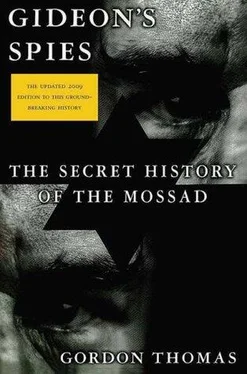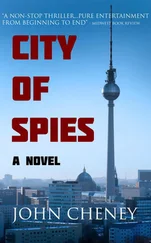Three days after leaving the helicopter, on that cold December dawn, Shalom lay prostrate in the Iraqi wadi. Beneath his hupta he wore goggles; their lenses gave the dark landscape a crepuscular definition. The only weapon Shalom carried was one the Sarami would expect to find on him: a hunting knife. He had been taught to kill with that in a number of ways. Whether he would bother to use it against a superior force, he did not know—any more than whether he could turn it on himself. Or simply commit suicide with the lethal pill he carried. Since Eli Cohen’s torture and death, a katsa operating in Iran, Iraq, Yemen, or Syria had been given the right to kill himself rather than fall into the hands of barbaric interrogators. Meanwhile, Shalom continued to watch and wait.
The nomads in their camps half a mile away beyond the wadi had begun to recite their first prayers of the day. Already the bark of their dogs carried faintly on the wind, but the animals would not venture beyond the camp until the sun was above the horizon: behavioral patterns were among the first lessons Shalom had learned in desert survival.
According to the information he had been given at his briefing, the convoy should appear between the encampment and the hills to his left. To an untutored eye, the track they would travel over was invisible. To Shalom it was as clear as a well-signposted road: the tiny rumplings of sand were created by desert moles burrowing between vehicle tracks.
The sun was high when the convoy finally appeared: a Scud missile launcher and its support vehicle. It was still about half a mile away when it stopped. Shalom began to photograph and time what he saw.
It took the Iraqi crew fifteen minutes to launch the Scud. It rose in an arc and disappeared over the horizon. Minutes later the convoy was moving at speed toward the hills. In a few minutes that Scud could have hit Tel Aviv or any other Israeli city if the launch had not been a practice. Shalom then began the long journey back to Tel Aviv.
Six weeks later, on January 12, 1991, Shalom was among a joint team of Mossad and Aman intelligence officers who sat around the conference table at the United States Joint Special Operations Command, JSOC (its staff called it “jaysock”), at Pope Air Force Base, Georgia. JSOC commanded the Green Berets and the SEALs, and had maintained a close working relationship with Mossad.
After Shalom had returned from Iraq, Shavit had informed General Earl Stiner, operations commander of JSOC, that Saddam was doing more than posturing. The hard-charging general had a folksy style and a salty language the Israelis liked. But in a war room, his Tennessee drawl swiftly gave way to shrewd decisions. As the nation’s top commando, he knew the value of good intelligence, and his own experience of the Middle East had convinced him Mossad offered the best.
Since Saddam’s incursion into Kuwait, Stiner had regularly communicated with his Israeli contacts. Some of them went back to 1983, when, as a newly promoted brigadier general, he had been secretly sent by the Pentagon to Beirut to report directly to the Joint Chiefs of Staff on how far the United States should become embroiled in the Lebanon war.
Later, he had worked closely with Mossad during the Achille Lauro hijacking, swooping down with his Delta Force commandos on an Italian air force base in Sicily where the hijackers had stopped over in an airliner on their way to freedom out of Egypt. Italian troops had stopped Stiner from capturing the hijackers, and there had nearly been a shoot-out. Thwarted, Stiner had flown in hot pursuit of the airliner in his own military transport, only abandoning the chase when both planes entered Rome’s airspace and its air traffic controllers threatened to shoot down the Delta Force aircraft for “air piracy.” In 1989 Stiner had been the ground commander for the invasion of Panama, and had been responsible for the swift capture of Manuel Noriega.
Only Joint Chiefs chairman General Colin Powell and General Norman Schwarzkopf, in charge of the coalition forces, knew about Stiner’s relationship with Mossad. While Schwarzkopf battled to create a defensive line along the Saudi border to deal with a thrust out of Kuwait by Iraqi forces, Stiner’s intelligence officers were working closely with Mossad to form resistance movements inside Iraq to try to topple Saddam.
When Major General Wayne Downing, commander of JSOC, called the meeting to order in the conference room, everyone knew that, as the hours ticked by to the deadline for war set by the United Nations for Tuesday, January 15, 1991, the world was conducting a dialogue with the deaf in Baghdad. Saddam continued to welcome what he predicted would be “the mother of all wars.”
Downing began by reminding his listeners that Washington still required Israel to remain out of the war. In return there would be long-term political and economic benefits for doing so.
The immediate response from the Israelis was to produce a set of Shalom’s enlarged photographs of the Scud launch. Then came their questions. Supposing Saddam fitted a nuclear warhead to a Scud? Mossad was satisfied Iraq had already built the facilities needed to manufacture a crude device. It also had the capability to fit chemical or biological warheads to its Scuds. Was Israel supposed to wait for that to happen? What was the coalition force’s plan to deal with the Scuds before they were launched? Did the Americans have any idea just how many Scuds Saddam had?
One of Downing’s intelligence officers said their “best estimate” was about fifty.
“We think Saddam has about five times that number, maybe even five hundred in all,” replied Shabtai Shavit.
The stunned silence in the room was broken by Downing’s question. Could he pinpoint them? Shavit could not be more specific than to suggest the Scuds were sited in the Iraqi western desert and in the east of the country. The Americans agreed with Downing that “that was a lot of desert to hide them in.”
“Then the sooner you start, the better,” Shavit said, not bothering to conceal his frustration.
Downing promised to pursue the matter vigorously, and the meeting closed with the repeated reminder that Israel must stay out of the coming conflict—but all the intelligence Mossad and Aman could gather would be welcomed. In the meantime, they could be reassured the United States and its partners would deal with the Scuds. The Israeli team flew home feeling they had gotten the worst end of the deal.
Shortly after 3:00 A.M. on the morning of January 17, 1991—hours after the start of the Desert Storm conflict—seven Scuds hit Tel Aviv and Haifa, destroying 1,587 buildings and injuring forty-seven civilians.
Later that morning Prime Minister Yitzhak Shamir icily asked over a hot line to Washington how many Israelis had to die before President Bush did something. The short call ended with Bush pleading for restraint and Shamir warning that Israel would not remain much longer on the sideline.
Shamir had already ordered Israeli jets to patrol the northern airspace with Iraq. Bush immediately promised that if the aircraft were recalled, he would send “in double quick time” two Patriot antimissile batteries “to further defend your cities,” and the coalition forces “will destroy the remaining Scuds in days.”
Missiles continued to fall on Israel. On January 22, one landed in the Tel Aviv suburb of Ramat Gan. Ninety-six civilians were injured, several seriously; three died of heart attacks. The sound of the explosions carried to Mossad headquarters. In the Kirya, Amnon Shahak called a direct line number to the National Military Command Center on the second floor of the Pentagon. His call was even shorter than Shamir’s; the gist was: Do something or Israel will.
Читать дальше












